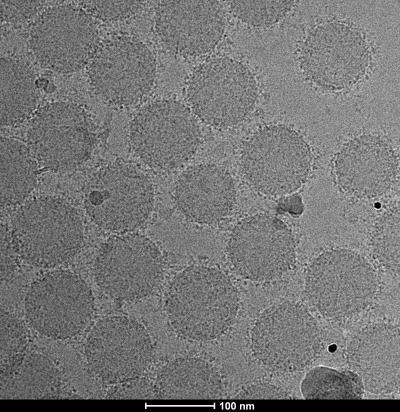Jun 18 2019
Researchers from Brigham and Women's Hospital are making the most of an exclusive phenomenon of nanoparticles to design a test for early detection of various types of diseases, including cancer.
In earlier research, Morteza Mahmoudi, PhD, currently a biomedical scientist in the Department of Anesthesiology, Perioperative and Pain Medicine, and colleagues have demonstrated that biomolecules in the blood of healthy persons and patients form numerous corona profiles around nanoparticles. Similar to dipping a donut hole in powdered sugar, nanoparticles tend to gather a unique coating of proteins from the blood.
 Transmission electron microscopy image showing the formation of biomolecular corona around the surface of nanoparticles. (Image credit: Morteza Mahmoudi, Brigham and Women's Hospital)
Transmission electron microscopy image showing the formation of biomolecular corona around the surface of nanoparticles. (Image credit: Morteza Mahmoudi, Brigham and Women's Hospital)
In a new research published in the Royal Society of Chemistry's peer-reviewed journal Nanoscale Horizons, Mahmoudi and the team showed proof that these coronas are personalized and exact, with various compositions or patterns in people having cancers. They have built a sensor array that has been experimented on blood samples, both from people diagnosed with five different kinds of cancer as well as supposedly healthy people who opted to have a cancer diagnosis many years later. The team's aim is to prepare an early detection test that could be used in the clinic to detect those at risk of cancer and other diseases.
"For cancer and many other catastrophic diseases, the earlier you can diagnose, the more likely you can treat and extend survival and attain better quality of life," said Mahmoudi, the paper's corresponding author. Mahmoudi is the former director of the nanobio interactions laboratory at Tehran University of Medical Sciences where he started this research in 2014. "The goal here is to develop a strategy to help people get better information about their health. Today, in the clinic, we have ways to measure lipids and predict risk of cardiovascular disease, but limited ways for cancer. If everything goes well, we hope our work will lead to a screening test for the earliest signs of cancer."
To perform their exploration, the team combined the theories of disease-specific protein coronas with sensor array technology. Sensor arrays can ascertain a wide range of interacting biological and chemical compounds at the same time instead of in isolation.
To test blood samples for early patterns of disease, the team created a sensor array that comprised of three diverse cross-reactive liposomes — fatty molecules that triggered protein coronas to form around them. The team analyzed samples from five patients, each with a different type of cancer: glioblastoma, lung cancer, myeloma, meningioma, and pancreatic cancer.
The researchers learned that the selected pattern of corona composition, through innovative classification methods detected by the nanoparticle sensor array, delivered an exclusive "fingerprint" for each type of cancer. The researchers also tested the tool using blood from 15 people who were then diagnosed with lung, brain, and pancreatic cancer up to eight years later, finding that their method could identify and distinguish the cancers at the very early stages.
Although favorable, as with other diagnostic methods, the team's initial results will have to be validated in a larger group of people to ensure the test not only functions but also offers accurate diagnostic information. Mahmoudi and his colleagues are also keen to apply the technology beyond cancer to detect other diseases at an early stage.
The only reason I'm in science is to do something that can help patients. When I see predictions about cancer, the number of new cases each year and its global burden, it excites me to think that our multidisciplinary expertise in nanobio interfaces, sensor array, and advanced statistics may offer a way to help. There is so much potential here and we are working to tap into it.
Morteza Mahmoudi, PhD, Biomedical Scientist, Department of Anesthesiology, Perioperative and Pain Medicine, Brigham and Women's Hospital